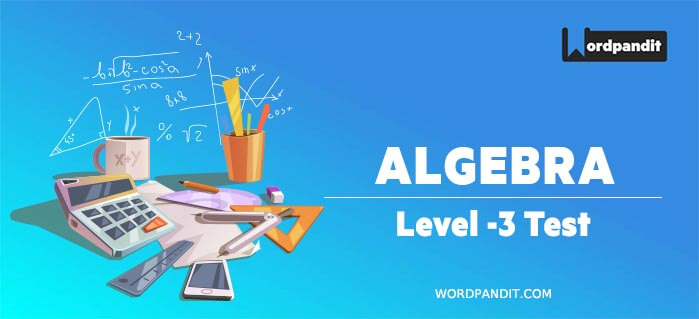-
[slider]
- This is an assessment test.
- To draw maximum benefit, study the concepts for the topic concerned.
- Kindly take the tests in this series with a pre-defined schedule.
Algebra Level 3 Test 4
Congratulations - you have completed Algebra Level 3 Test 4.You scored %%SCORE%% out of %%TOTAL%%.You correct answer percentage: %%PERCENTAGE%% .Your performance has been rated as %%RATING%%
Your answers are highlighted below.
Question 1 |
The total number of integers pairs (x, y) satisfying the equation x + y = xy is
0 | |
1 | |
2 | |
None of the above. |
Question 1 Explanation:
Given equation is x + y = xy
⇒ xy – x – y + 1 = 1
⇒ (x – 1)(y – 1) = 1
x – 1= 1
and y −1= 1or
x −1= –1
y – 1= –1
Clearly (0, 0) and (2, 2) are the only pairs that will satisfy the equation
⇒ xy – x – y + 1 = 1
⇒ (x – 1)(y – 1) = 1
x – 1= 1
and y −1= 1or
x −1= –1
y – 1= –1
Clearly (0, 0) and (2, 2) are the only pairs that will satisfy the equation
Question 2 |
If | b |≥ 1 and x = − | a | b , then which one of the following is necessarily true?
a – xb < 0 | |
a – xb ≥ 0 | |
a – xb > 0 | |
a – xb ≤ 0 |
Question 2 Explanation:
x = –|a| b
Now a – xb = a – (– |a| b) b
= a + |a|b2
Therefore a – xb = a + ab2 …a ≥ 0
OR
a – xb
= a – ab2 …a < 0
= a(1 + b2) = a(1 – b2)
Consider first case:
As a ≥ 0 and |b| ≥ 1, therefore (1 + b2) is positive.
Therefore a (1 + b2) ≥ 0
Therefore a – xb ≥ 0
Consider second case.
As a < 0 and |b| ≥ 1, therefore (1 – b2) ≤ 0
Therefore a (1 – b2) ≥ 0 (Since –ve × -ve = +ve and 1 – b2 can be zero also), i.e. a – xb ≥ 0
Therefore, in both cases a – xb ≥ 0.
Now a – xb = a – (– |a| b) b
= a + |a|b2
Therefore a – xb = a + ab2 …a ≥ 0
OR
a – xb
= a – ab2 …a < 0
= a(1 + b2) = a(1 – b2)
Consider first case:
As a ≥ 0 and |b| ≥ 1, therefore (1 + b2) is positive.
Therefore a (1 + b2) ≥ 0
Therefore a – xb ≥ 0
Consider second case.
As a < 0 and |b| ≥ 1, therefore (1 – b2) ≤ 0
Therefore a (1 – b2) ≥ 0 (Since –ve × -ve = +ve and 1 – b2 can be zero also), i.e. a – xb ≥ 0
Therefore, in both cases a – xb ≥ 0.
Question 3 |
If 13x + 1 < 2z and z + 3 = 5y2, then
x is necessarily less than y | |
x is necessarily greater than y | |
x is necessarily equal to y | |
None of the above is necessarily true |
Question 3 Explanation:
13x + 1 < 2z and z + 3 = 5y2
13x + 1 < 2 (5y2 − 3)
13x + 1< 10y2 − 6
13x + 7 < 10y2 put x = 1
20 < 10y2 and y2 > 2
Therefore y2 > 2 = (y2 − 2) > 0
so option d is the right answer
13x + 1 < 2 (5y2 − 3)
13x + 1< 10y2 − 6
13x + 7 < 10y2 put x = 1
20 < 10y2 and y2 > 2
Therefore y2 > 2 = (y2 − 2) > 0
so option d is the right answer
Question 4 |
If n is such that 36 ≤ n ≤ 72 , Then a = {(n2 + 2√n(n+ 4) +16)} / (n+ 4√n +4) satisfies
20 < x < 54 | |
23 < x < 58 | |
25 < x < 64 | |
28 < x < 60 |
Question 4 Explanation:
36 ≤ n ≤ 72
We are given by
a = {(n2 + 2√n(n+ 4) +16)} / (n+ 4√n +4)
Put a = 36.
And get the value 28 which is the least value
We are given by
a = {(n2 + 2√n(n+ 4) +16)} / (n+ 4√n +4)
Put a = 36.
And get the value 28 which is the least value
Question 5 |
Consider the sets Tn = {n, n +1, n + 2, n + 3, n + 4} , where n = 1, 2, 3,…, 96. How many of these sets contain 6 or any integral multiple thereof (i.e. any one of the numbers 6, 12, 18, …)?
80 | |
81 | |
82 | |
83 |
Question 5 Explanation:
From the question we can observe that 6 will appear in 5
sets T2, T3, T4, T5 and T6.
Similarly, 12 will also appear in 5 sets
But the multiple of 6 appears in the next 5th set
that is in T12 Thus, each multiple of 6 will appear in 5 distinct sets.
Therefore we can say that there will be 16 multiplies of 6 till 96 .
Therefore 16 multiples of 6 will appear in 16 × 5 = 80 sets.
sets T2, T3, T4, T5 and T6.
Similarly, 12 will also appear in 5 sets
But the multiple of 6 appears in the next 5th set
that is in T12 Thus, each multiple of 6 will appear in 5 distinct sets.
Therefore we can say that there will be 16 multiplies of 6 till 96 .
Therefore 16 multiples of 6 will appear in 16 × 5 = 80 sets.
Once you are finished, click the button below. Any items you have not completed will be marked incorrect.
There are 5 questions to complete.
List |




